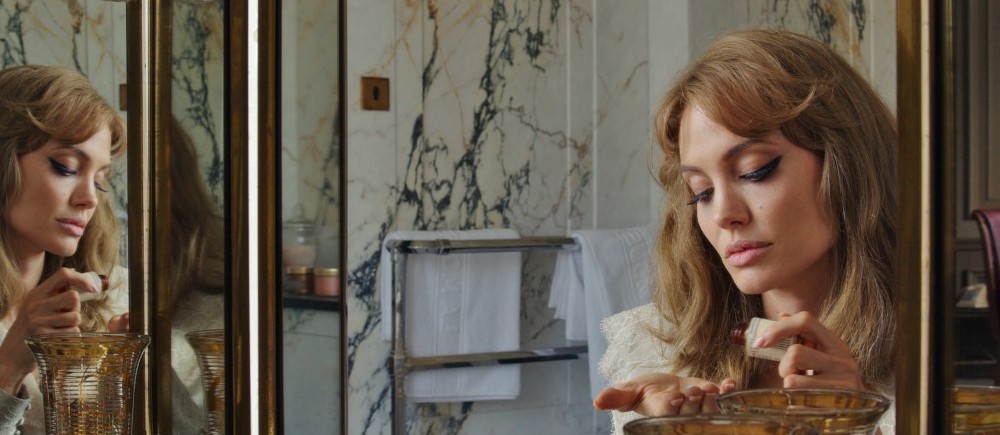A film written and directed by Angelina Jolie and starring both herself and her husband Brad Pitt, as Vanessa and Roland respectively – a couple whose marriage is on the not-so-subtle allegorical rocks below the Mediterranean French hotel in which they stay throughout the movie (it was filmed in Malta), was always going to arouse conjecture regarding possible correlations between fact and fiction (this is the first time the lady in question has listed herself as Angelina Jolie-Pitt, perhaps anticipating such gossip), much as orgy themed ‘Eyes Wide Shut’ (99) did when it was released with its famous married couple Nicole Kidman and Tom Cruise: shortly before they broke up. Given events in the film, the central pair here will be hoping no one reads into it too much, lest they should encounter whispers of ‘better not invite Angelina and Brad, they are massive perverts’.
There is a deliberate attempt to evoke arthouse film here, with influences from the likes of Antonioni, Fillini and even Bergman, and whilst it never comes close to the work of those masters, Jolie has nevertheless attempted something fairly, if you’ll pardon the pun, off-the-wall, which she deserves credit for – as former dancer Vanessa whiles away her miserable hours in their hotel room, her failed author husband drinking a bottle of beer for every line he thinks about writing, until one day she notices a sizeable hole bored so that the neighbours next door can be spied on at will. After very brief consideration, she partakes.
Jolie’s directing is better than her last attempt, ‘Unbroken‘, at a very fundamental level – early shots of the setting interject closer views of the characters and help to give us a framework, showing us the surroundings in much the same way we take mental snapshots of the most memorable views of the places we visit, and her work behind the camera feels at once marked in the right places and also disguised where it should be (though I note one of the opening brief shots is quite randomly of two cats. A reference to something perhaps?)
There is a conceit with this man-made gap in the wall – as we view it there is no earthly way that the couple next door (played by Mélanie Laurent and Melvil Poupaud) wouldn’t notice the thing, especially since they effectively look right at it several times over. However, we see what the protagonists do, which effectively means we’re looking through a lens to cover the space in the room that the view does – of course this is the conspicuous lens of the camera but since we never see the peephole from the victims’ room, who is to say it wasn’t created with an actual lens? If that were the case, whosoever created the thing would have probably also gone to lengths to disguise it, and indeed sound wouldn’t travel as well as it would through a simple hole.
Similarly, regarding the film’s central driving motif – the mystery over why their relationship is in tatters and what connection, if any, this has to the voyeurism, only so many options are dangled in front of us before all is revealed and you’re left both unsurprised and also wondering if it really fits with everything before. However, if you really read between the lines there are a couple of potential events in their past which you could say are hinted at and no more, and if true then they would justify events in the film to a much greater degree, but you really have to want to piece it together and the movie itself isn’t focused enough to deliver where it needed to.
Much of the premise does work, it’s really the middle section that needed to be a lot more intricate – as it is there’s a flatness to it, a cold distance between the voyeur and the act of viewing, as if it’s being done out of simple ennui and that perhaps Jolie wasn’t quite willing to go the full distance and show masturbation onscreen, for example. Though, again, if the lack of arousal was intentional then it’s only really justified by a significant investment from the audience (in the real world). Other peripheral elements could also have been tighter – like the local barkeep, played by Niels Arestrup, divulging his life story and philosophy almost straight away instead of attempting more poignancy later on perhaps.
Still, lots of elements are really well done – the visuals with their prevalence of white against the sunny, sandy landscapes all set in the 60s/70s, are beautifully shot and immediately bring to mind the recent ‘The Two Faces of January‘. Both leads deliver great performances, with Jolie rarely more radiant onscreen and evoking shades of Bardot when she gets dressed up for the evening, and there are a number of key moments that work well, especially when delving into the sadness and pain of each character. The film proves interesting enough to draw you in throughout, and even if it ultimately doesn’t reach the level of the kind of art that inspired it, it is still reasonably successful on its own terms. Plenty of signs of promise from the determined writer/director.

